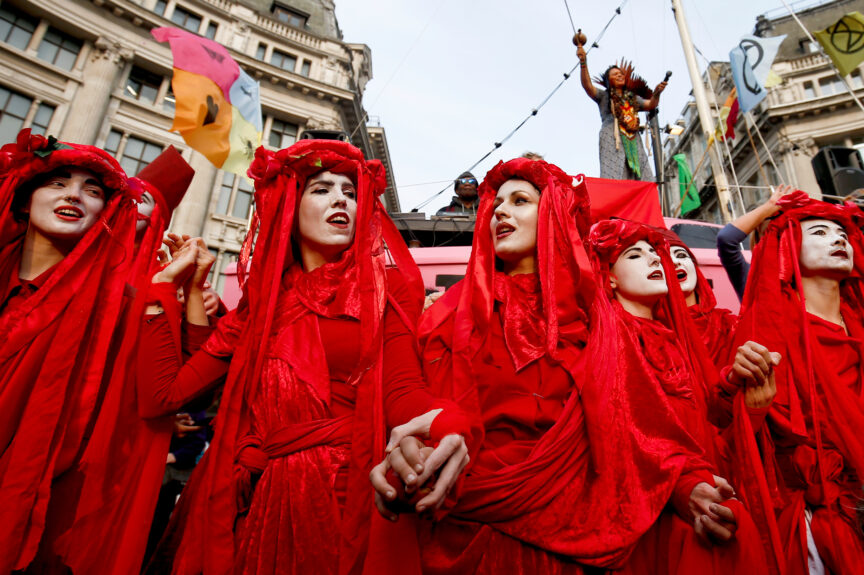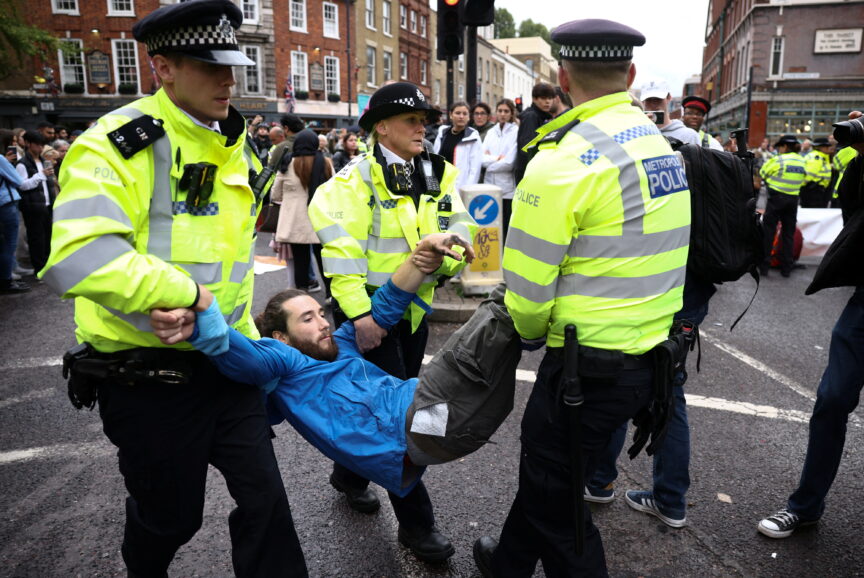Is Extinction Rebellion’s Structure Fit for Purpose?

In the early hours of 17 October 2019, Extinction Rebellion activists staged protests across several east London train stations. In Canning Town, they climbed on top of tube carriages and held up a banner which read “BUSINESS AS USUAL = DEATH”.
The aim was to stop commuters headed for London’s financial district as part of XR’s two-week International Rebellion campaign. The group’s success that April had forced the UK parliament to declare a climate emergency, and, six months on, it wanted further commitments to climate action.
The tube action wasn’t well received by the public. Activists were physically assaulted, and eight arrests were made. At the time, only 13% of Brits said they had sympathy for the activists. The protests also caused division within the climate movement. Some felt the target of the action was misguided, largely taking place in historically working class areas of London and disrupting those going to work. Within XR, people feared the incident had alienated potential supporters.
Ben*, who joined XR in April 2019 and left in 2020, explains that before the Canning Town incident, ‘rebels’, or XR activists, were polled about whether or not it was a good idea. “A huge percentage of them said no, but then they did it anyway,” he recalls. This is because the action met a list of guidelines set out by XR. “Once you accept that framework, you can literally do any action you like,” he says. “The problem is that loads of people in XR might do some actions, but might really hate or disagree with others, and they have absolutely no control over that.”
While XR’s loose and non-hierarchical organisational structure no doubt contributed to the movement’s rapid growth in its early days, the Canning Town incident is just one example of the challenges that have arisen from that. Ahead of the group’s most ambitious mobilisation yet, has anything changed?
‘It was a minefield’.
XR UK is a decentralised, non-hierarchical, grassroots movement. It operates through a network of autonomous local groups, “community groups” (like XR Youth, Doctors for XR) acting independently but united by a set of principles and values, and the UK Rebel Hive, which is made up of working groups such as Operations, Strategy and Systems and Culture as well as representatives of local and community groups. The UK Rebel Hive is often referred to as the national team.
XR’s decision-making processes are focused on consensus-building and participation, and the movement uses a ‘self-organising system’ and works within teams called ‘circles’ to organise. Activists don’t formally need to join XR, as there’s no central membership list.
Ten “principles of rebellion” guide the movement. These include creating a better world for generations to come, valuing reflecting and learning, creating safe and accessible spaces, actively breaking hierarchies of power, and using non-violent strategies.
XR is funded by crowdfunding, major donors, NGOs, trusts and foundations. The movement has no paid “staff”, and only 3% of volunteers receive expenses to help with their living costs.

Activists say there have been many strengths to this structure – particularly when it comes to mobilising and decision-making speed. “In the early days of XR, it was incredibly helpful to have such a flexible and dynamic structure,” says Sam Knights, who helped establish XR in London in 2018 and left the movement in late 2019. “It allowed us to burst onto the scene very quickly. Protest after protest, people turned up en masse.”
“XR provided you with a series of principles and guidelines about how to do direct action,” Ben explains. “It created a DIY culture where people could literally just go: ‘Ok, I’m going to do this on that day, no one’s going to stop me. I don’t have to consult anybody’.”
But from the beginning, XR’s structure was also at the core of the group’s difficulties. In Knights’ view, XR’s structure started feeling a strain when its popularity soared in April 2019, and lots more people were brought into the movement. “The structures weren’t designed to be democratic or accountable in the way many leftists are used to organising,” he explains.
This led to problems when it came to how decisions were made, and who was in charge. “You were often like, ‘I don’t know who is fucking in control here, and I don’t know who to speak to,” Ben recalls. “It was a minefield.”
Specifically, as XR cemented its place in the national conversation, the national team’s position on issues became XR’s position in the mind of the public. “What they were saying became much more important, and that itself [became] a site of struggle,” Knights explains.
In particular, local and community group activists often felt unable to influence the national team’s decisions over the movement’s politics in the way they might have liked. “A lot of people like myself in local groups really wanted solid climate justice reform, but we couldn’t get that pushed into the programme and [the] national group] kept trying to block it,” says Ben.
Informal hierarchies also dictated decision-making. These hierarchies often mirrored power dynamics in wider society, with older, white, middle-class people often having the final word. In the summer of 2019, for instance, there was a clash between XR Youth and older activists in the national team over a plan to fly drones over Heathrow. XR Youth was opposed to the idea – and their opposition was met with resistance in a meeting with XR’s national team. “I guess society was playing out in that room big time,” said Savannah Lovelock, an activist with XR Youth, as documented in the 2022 documentary Rebellion.
In this instance, XR abandoned the Heathrow action, and issued a statement apologising for “failing to address adult privilege” (although a few activists, including Roger Hallam – an XR co-founder and Lovelock’s father – nonetheless attempted it in September under the banner of Heathrow Pause). But in other cases, such as in Canning Town, XR’s decision-making structure meant actions went ahead despite widespread opposition.
“In a social movement […] that organises in a decentralised way, you’re always going to get some idiots making mistakes,” Knights argues. “And quite frankly, sometimes you’re going to get great people making mistakes too.”
Learning lessons.
Following Hallam’s departure from XR in 2020, activists who wanted to focus on blocking roads and getting arrested followed him into groups like Insulate Britain and Just Stop Oil. Amongst those who were left, many wanted to focus on what had led to divisions within XR, address the problems arising from the movement’s decentralised structure, and invest in slow and sustainable growth.

In 2020, XR launched the Systems Realignment Project – a review into what needs changing within the movement. This includes issues related to XR’s structure, acknowledging that “XR grew so quickly that its core systems struggled to keep up”, including how to onboard new rebels properly, communicate between circles, and resolve conflicting opinions.
The resulting recommendation was to streamline XR’s structure. In 2022, XR stated it would be adopting “a momentum-driven approach where authority can be distributed throughout the movement” to enable XR to be “more autonomous in local areas” and “more coherent when we come together in rebellion”.
New roles like ‘integrators’ and ‘gardeners’ have been introduced to guide new members and grow XR in a sustainable way. In September 2022, in part as an attempt to unify the movement, XR also launched a fleet of ‘rebellion buses’ which travelled to local groups across the country to “celebrate their work, offer tools and resources in mobilisation and citizen’s assemblies, and build a narrative across the movement”.
This, combined with a shift in strategy, seems to have had some success. Ahead of ‘The Big One’ – an XR-led mass mobilisation in London 21-24 April – activists say there’s more unity within the movement than ever before.
“There have been dissenters,” says one activist. “But by and large, the people within the movement – and I’ve spoken to over 500 since the announcement – people understand it, and people are with it.”
*Some people asked to be referred to by their first names only, or for their names to be changed.
This piece is part of a Novara Media mini-series looking at Extinction Rebellion’s changing tactics, politics and structure.
Diyora Shadijanova is a multimedia journalist and an editor at gal-dem magazine.


